This document discusses a comparative study on the seismic performance of conventional slab reinforced concrete (RCC) structures and flat slab RCC structures using pushover analysis. It aims to compare the structures' behavior under parameters like base shear, story displacement, and story drift. The study finds that under equivalent pushover analysis, the conventional slab RCC structure performs better with lower base shear, story drift, and story displacement values compared to flat slab and flat plate RCC structures. Overall, the conventional slab structure is considered more seismically efficient. The document provides background on pushover analysis methodology and outlines the objectives to explore and compare the seismic behavior of different slab RCC structures through nonlinear static analysis.
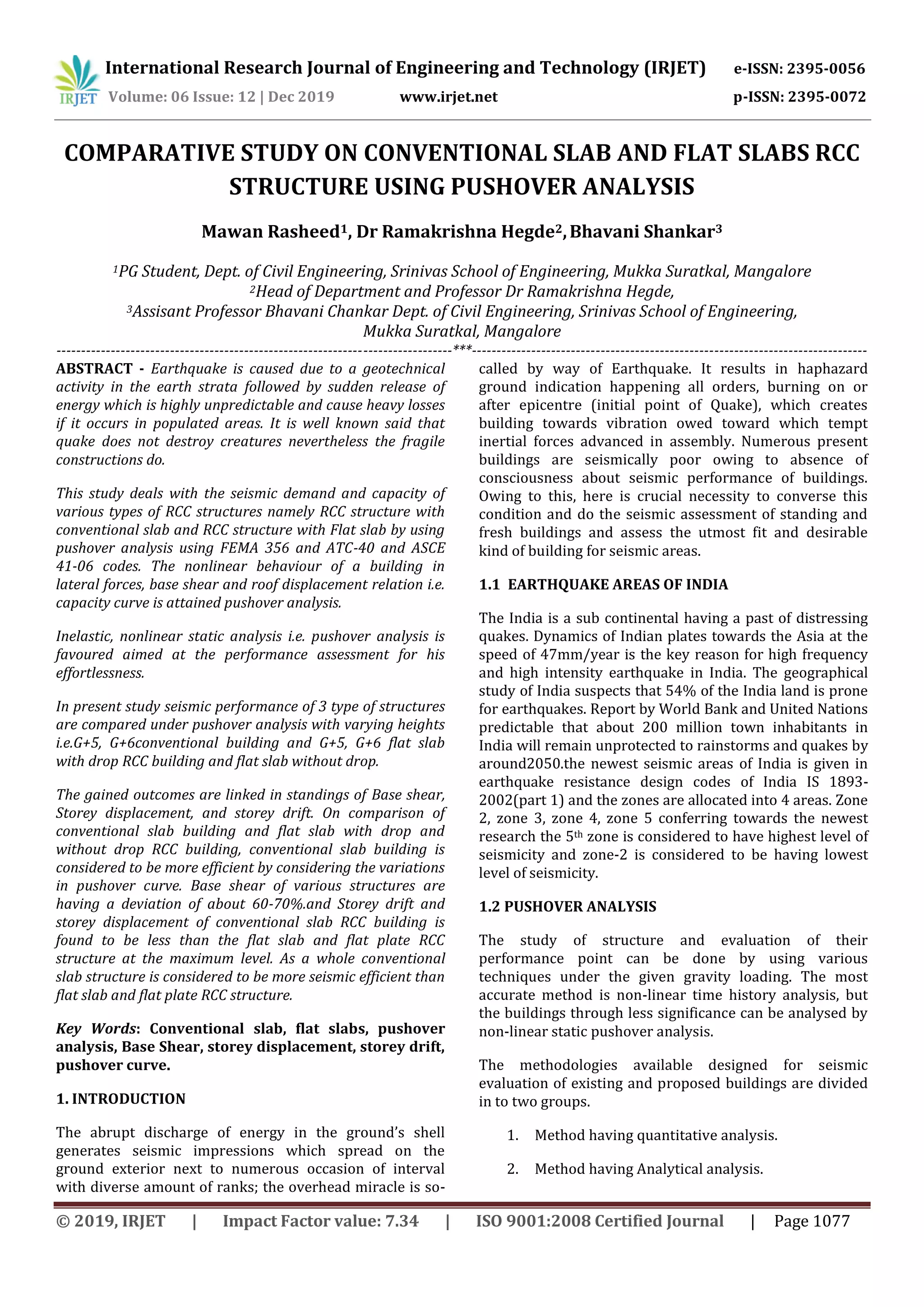
![International Research Journal of Engineering and Technology (IRJET) e-ISSN: 2395-0056
Volume: 06 Issue: 12 | Dec 2019 www.irjet.net p-ISSN: 2395-0072
© 2019, IRJET | Impact Factor value: 7.34 | ISO 9001:2008 Certified Journal | Page 1078
Seismic analysis is a subtopic of structural engineering
and exist the evaluation of response of structures for
ground motion and is the part of the structural design.
Seismic evaluation is very useful for earthquake work,
structural valuation and retrofitting in the region where
earthquake stay predominant. Structural analysis or
seismic analysis is further separated into the resulting
classes.
1. Equivalent Static Analysis.
2. Response Spectrum Analysis.
3. Linear Dynamic Analysis.
4. Nonlinear Static Analysis (pushover analysis).
5. Nonlinear Dynamic Analysis.
Pushover analysis is a parametric incremental non-linear
static analysis accepted to determine the capability of a
structure on basis of force vs displacement behaviour or to
determine required capacity curve for the various
structural component. The analysis contains enforcing
lateral loads to a digital prototype of the assembly
incrementally (i.e. pushing the structure), and comparing
the applied shear force at each steps.
Pushover analysis is a parametric incremental non-linear
static analysis procedure in which the degree of the
structural loading is incrementally amplified. By the
incremental intensification in the amount of the loading,
weak links and the means of failure of building are
established. The three simple fundamentals of this
technique are
Capacity: - It characterizes capability of the buildings
to counterattack the seismic demand the complete
capability of structure rest on the structural strength
and structural deformation capacity of various
component of building. Non-linear pushover analysis
is formulated towards determining the capability of
structure beyond its elastic limit
Demand: - It symbolizes the quake ground motion.
Horizontal displacement pattern is developed in a
structure during quake ground motion.
Performance: - It is crossing point of capacity
spectrum and demand spectrum
1.3 AREA OF STUDY
a) Understanding about interaction of RCC structure
with conventional slab and flat slabs arrangement
under the shaky ground condition.
b) To evaluate proposed as well as existing buildings to
implement on earthquake coverage up to the
potentials and in agreement with building codes.
c) To compare the RCC structures under various
parameters such as Base shear, Storey displacements,
Storey Drift, Height Variations etc.
1.4 PROPOSED WORK AND OBJECTIVES
a) To explore and understand standard static pushover
analysis with their gains, restrictions and dominance.
b) To use structural analysis software Etabs2016 and to
evaluate pushover analysis of RCC constructions
under various slabs attention.
c) To examine behavior and performance of
conventional slab RCC structure and Flat Slab with
drop and without drop RCC structures.
d) To study and assess several seismic valuation factors
such as pushover curve, capacity curve.
e) To evaluate the structures using pushover analysis by
various parameters such as base shear, storey
displacements, storey drift under height variations.
2. LITERATURE SURVEY
The non-linear static pushover analysis came into
existence in 1970’s, but the major requirement is observed
in the previous 10 to 15 years. This technique is mostly
used to evaluate the strength and seismic demand of a
structure of existing as well as proposed structure. The
application of pushover analysis and its evaluation
procedures brought in to several seismic guidelines like
FEMA 356, ATC-40 etc. in recent few years.
1. Ms. Nivedita N. Raut & Ms. Swati D. Ambadkar
(2013)
2. Neetu KN & Sajid KP (2015)
3. Mandanar Anusha (2016)
4. Syed Ahamed, Dr Jagadish G Kori
5. M. Mouzzoun et.al , O. Moustachi, A. Taleb, S. Jalal
6. A. Kadid et.al (2008)
7. Ms. Nivedita N. Raut et.al (2013)
8. S.C. Pednekar, [9]
3. THREORY AND FORMULATIONS
3.1 DESCRIPTION TO PUSHOVER ANALYSIS.
Pushover analysis for a building structure is an inelastic
non-linear static analysis considered instable vertical load
and incremental cumulative lateral loads. It is considered
to be one of the methods existing used to evaluate the
behavioural actions on structures under earthquake](https://image.slidesharecdn.com/irjet-v6i12176-200107063828/75/IRJET-Comparative-Study-on-Conventional-Slab-and-Flat-Slabs-RCC-Structure-using-Pushover-Analysis-2-2048.jpg)
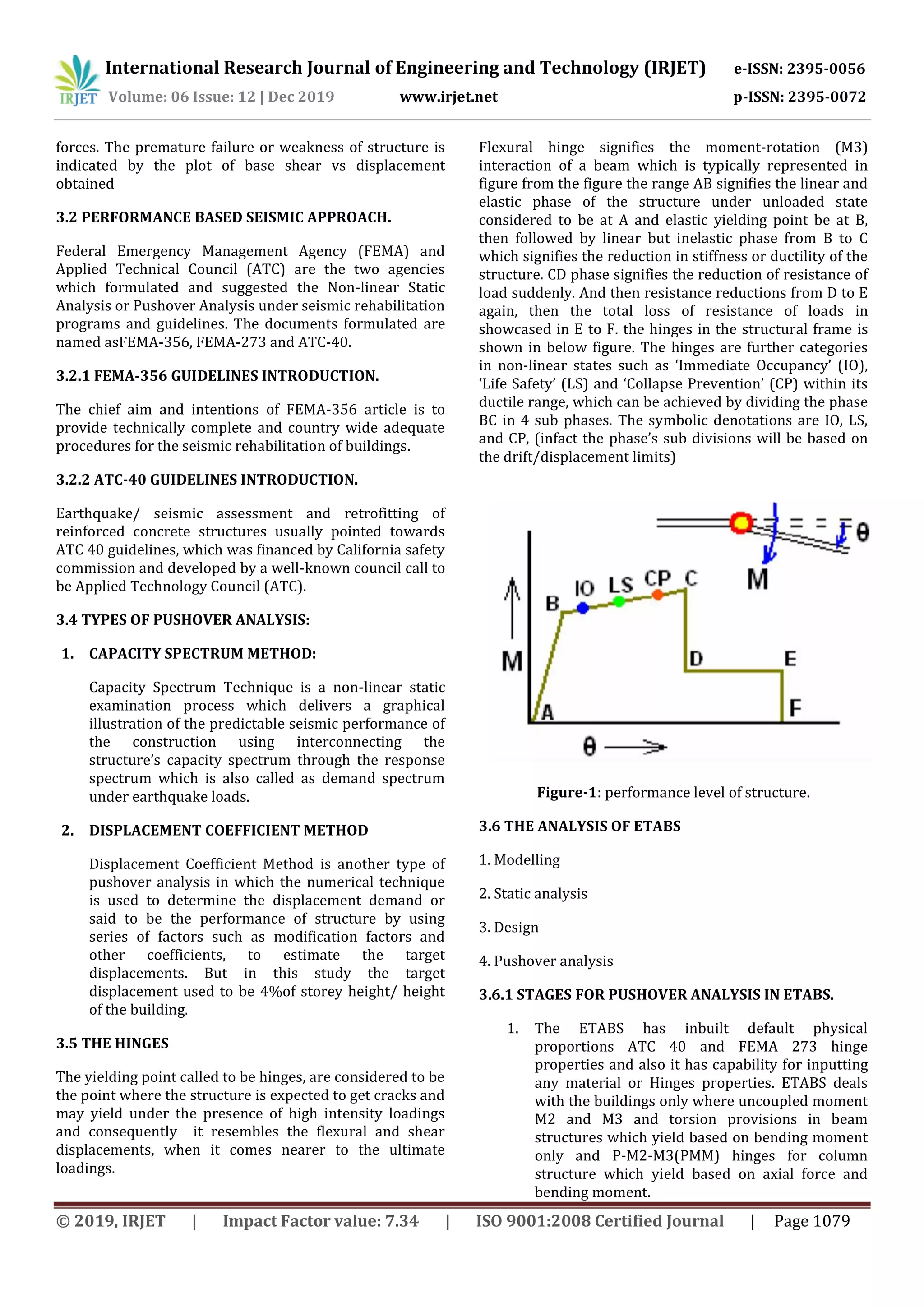
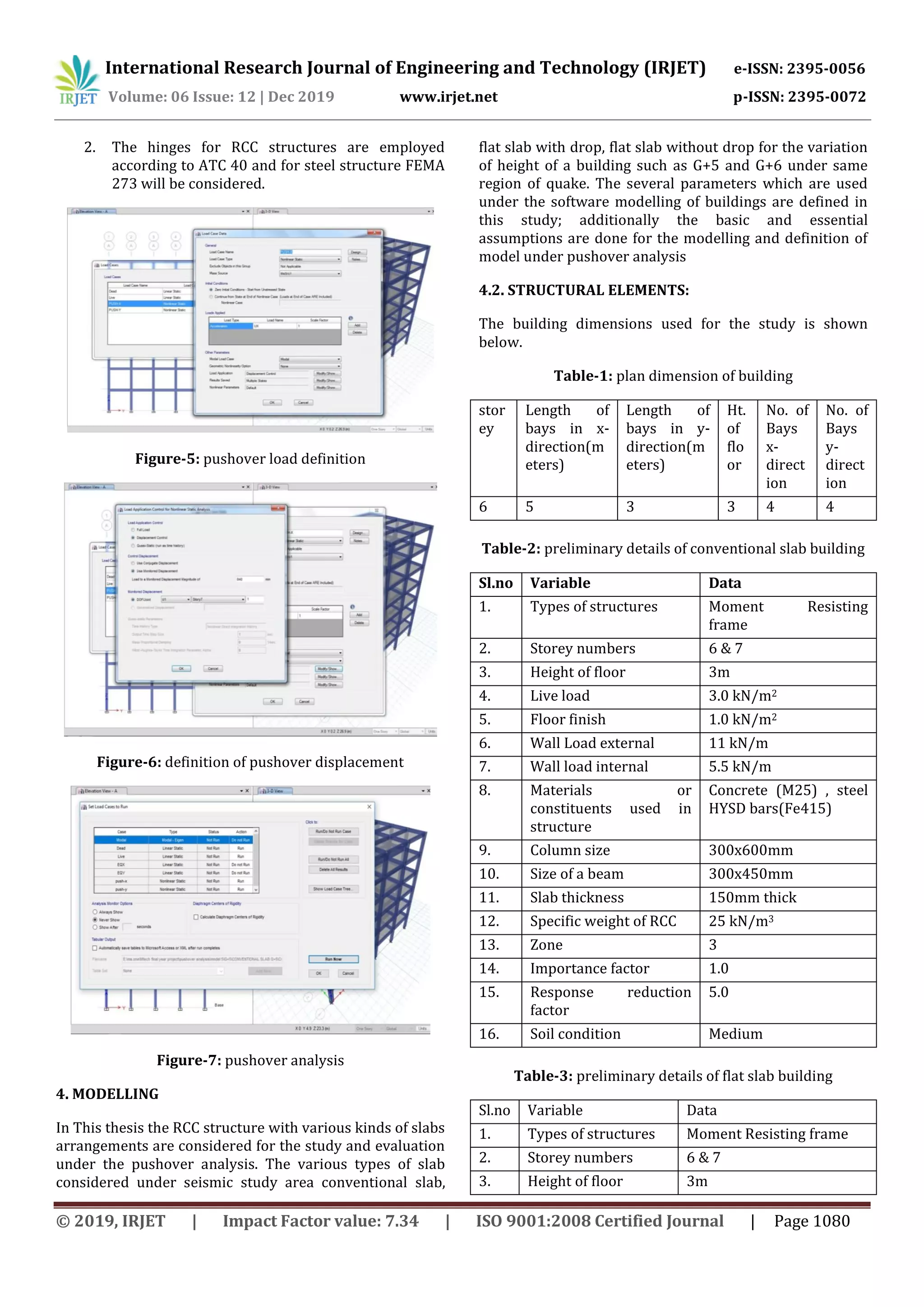

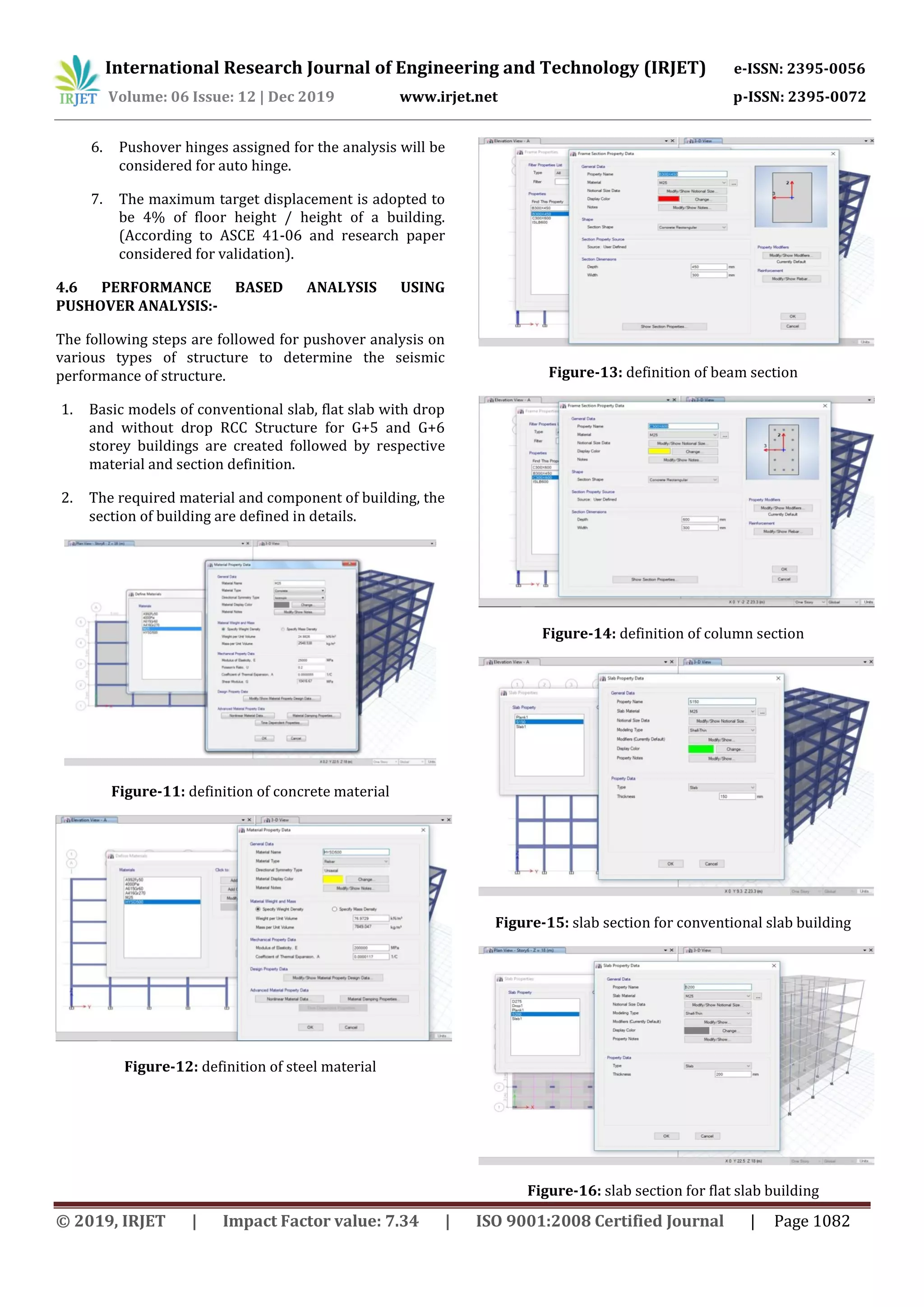
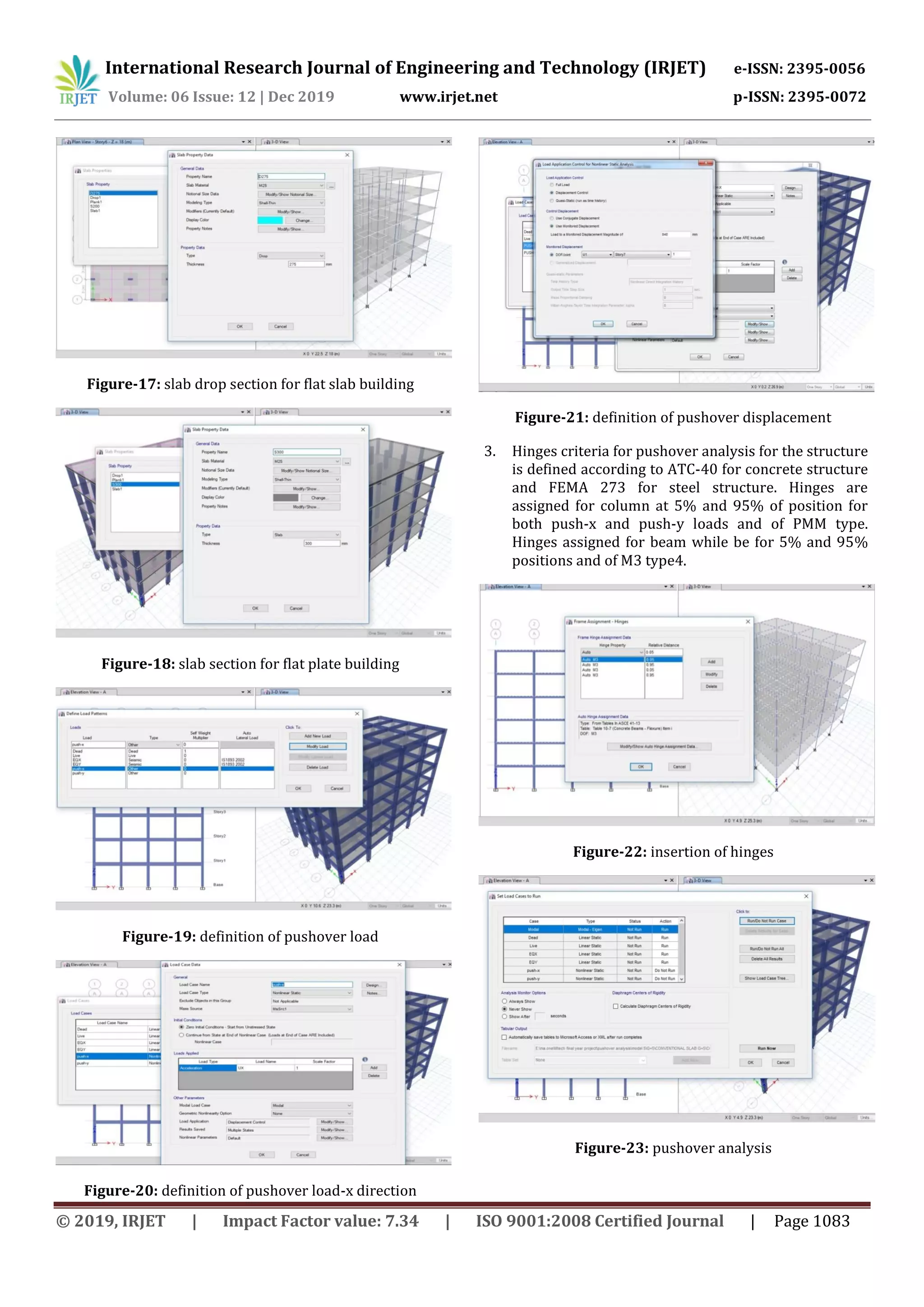
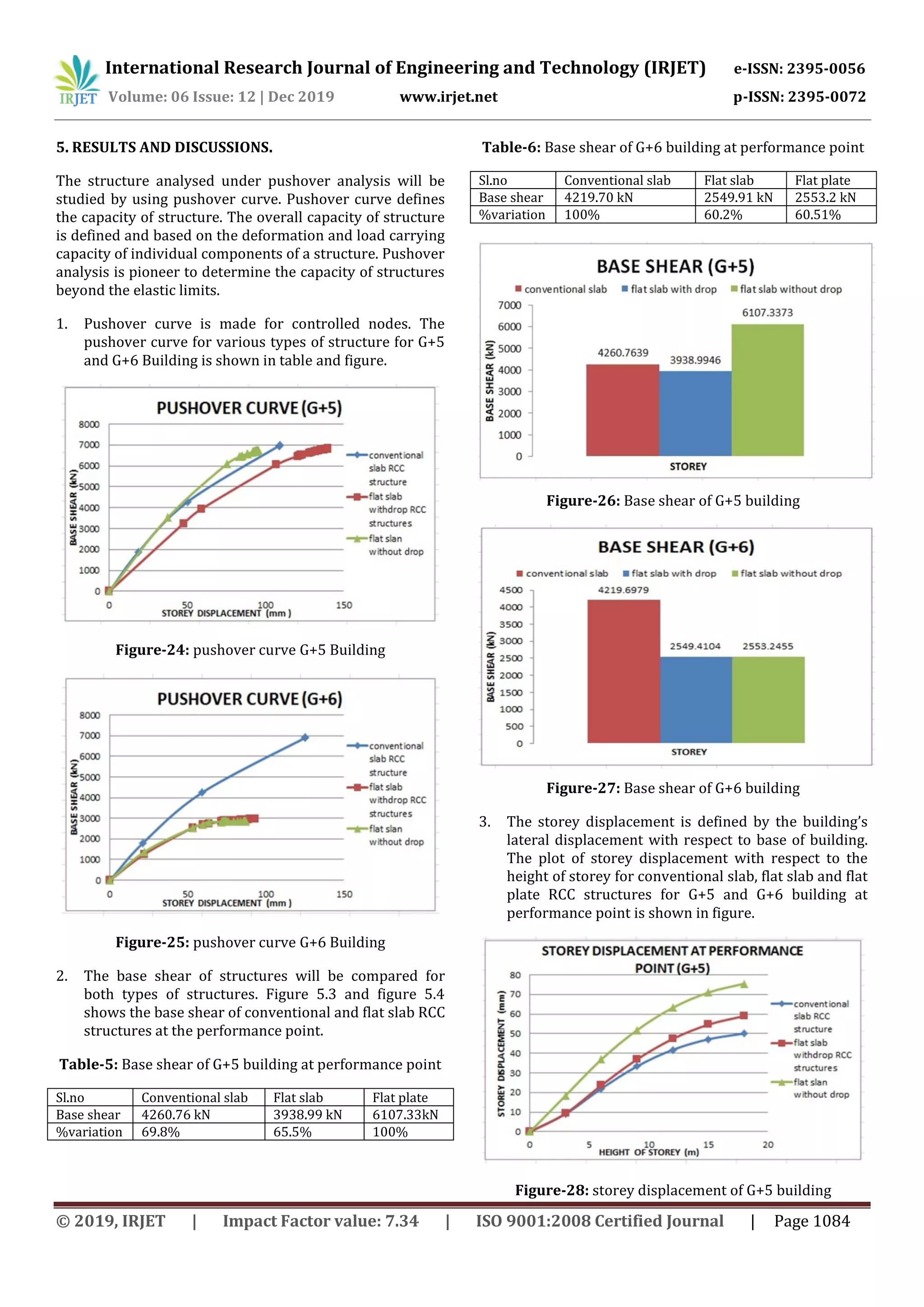
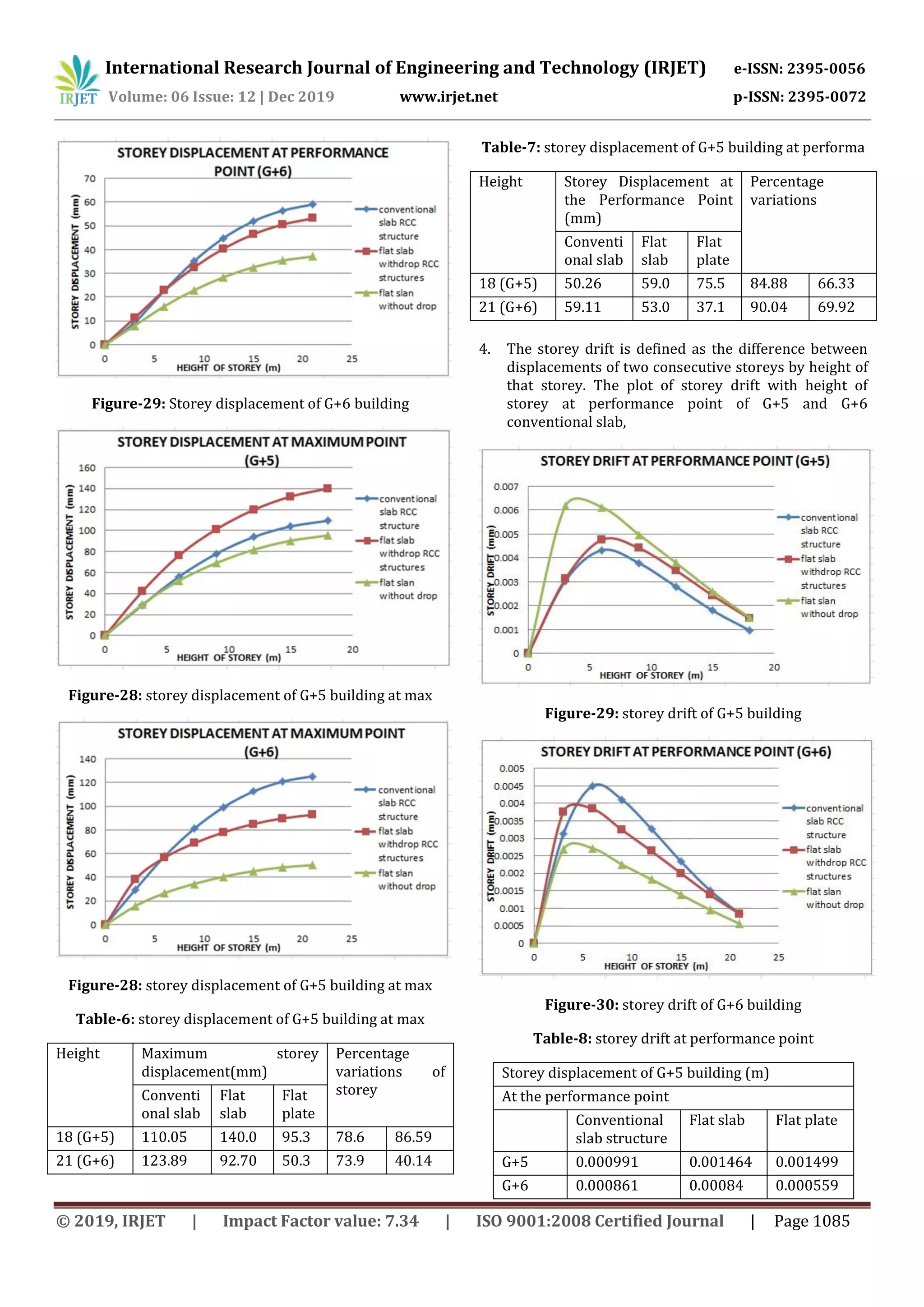
![International Research Journal of Engineering and Technology (IRJET) e-ISSN: 2395-0056
Volume: 06 Issue: 12 | Dec 2019 www.irjet.net p-ISSN: 2395-0072
© 2019, IRJET | Impact Factor value: 7.34 | ISO 9001:2008 Certified Journal | Page 1086
6. CONCLUSION AND SCOPE OF STUDY
1. Pushover analysis generally focuses on generation of
pushover curve, which represent lateral
displacement with the function of force and
considered to be the representation of capacity of
structure for seismic demand.
2. Base shear signifies stiffness and flexibility of
structure, the base shear for conventional slab, flat
slab with drop and flat slab without drop RCC
structure of G+5 and G+6 building at the performance
point is shown in above table the overall percentage
variation of base shear is considered to be 60-70%.
3. Base shear of flat slab without drop is more in case of
G+5 building followed by conventional slab building
and flat slab without drop structures. But as the
height of the structure increases the base shear of
conventional slab structure reduces slightly but there
is a drastic decrease in the base shear of flat slab with
drop and without drop structure.
4. It is concludes that the storey displacement of
conventional slab structure and flat slab with drop
structure is almost similar and flat slab without drop
structure displace more in compare with other two
structure for G+5 building at performance point.
5. Flat slab without drop structure displaced less in
compare with other two structures for G+6 building.
So at the performance point according to storey
displacement by height relationship the conventional
slab structure is considered to have same seismic
demand for G+5 building in compared with other two
buildings but in contrary the capacity of flat slab
without drop is compared to be more as the height of
building increases for G+6 building at performance
point.
6. The percentage variations of displacement
conventional slab and flat slab with drop structure in
G+5 and G+6 building is 79% and 74% respectively.
The percentage variations of displacement
conventional slab and flat slab without drop structure
in G+5 and G+6 building is 87% and 40%
respectively.
7. The storey drift is considered to be less for structure
having for efficient for seismic demand. From above
mentioned plot the conventional slab RCC structure is
more seismic efficient than flat slab with drop and
without drop RCC structure.
8. The storey drift of conventional slab RCC structure is
considered to be less in compared with other two
structures, but in contrary as the height of building
increases then the storey drift of conventional slab
RCC structure is considerably more than other two
structures.
9. There is considered changes in the base shear of
building on increase in number of storey. But in both
the cases the flat slab structures are considered to
more stiff than conventional slab RCC structure.
6.1 FUTURE SCOPE OF STUDY
1. The present study is analysed for G+5 and G+6 storey
building, which can be extended for tall structures as
well.
2. In present study symmetrical building is considered,
this study can be extended for asymmetrical section
which includes with effects involved with asymmetric
structure.
3. In above study, infill walls are not considered for
analysis, the structures with infill walls and with
different kinds on slabs can be considered for analysis.
4. The comparative study of concrete, steel and
composite can be used for the pushover analysis.
5. The comparative study on RCC or steel Structures by
using different types of pushover analysis can
employed for further study i.e. pushover analysis by
force control and pushover analysis by displacement
control.
REFERRENCE
[1] Ms Nivedita N. Raut & Ms Swati D Ambadkar,
“pushover analysis of multi-storey building” ISSN: 2249-
4596 Volume 13, Issue 4 (2013).
[2] Neetu KN & Sajid KP, “pushover analysis of RCC
building” ISSN: 2319-7046 Volume 4, Issue 8 (August
2015).
[3] Rathod Chiranjivi, Saddinent Ramakala, Mandala
Venugopal and, Mandanar Anusha, “seismic analysis of flat
slab with drop and conventional structure” ISSN 2278-
0181 volume 5 Issue 10 (October 2016).
[4] Syed Ahamed and Dr Jagdish G Kori “performance
based seismic analysis of an unsymmetrical building using
pushover analysis” ISSN 2321-7758 Volume 1, Issue 2
(2013).
[5] M. Mouzzoun, O.Moustachi, A. Taleb, S. Jalal, “Seismic
performance assessment of reinforced concrete buildings
using pushover analysis” ISSN: 2278-1684 Volume 5, Issue
1 (Jan. - Feb. 2013).
[6] A. Kadid and A. Boumrkik, “Pushover analysis of
reinforced concrete frame Structures” Asian journal of](https://image.slidesharecdn.com/irjet-v6i12176-200107063828/75/IRJET-Comparative-Study-on-Conventional-Slab-and-Flat-Slabs-RCC-Structure-using-Pushover-Analysis-10-2048.jpg)
![International Research Journal of Engineering and Technology (IRJET) e-ISSN: 2395-0056
Volume: 06 Issue: 12 | Dec 2019 www.irjet.net p-ISSN: 2395-0072
© 2019, IRJET | Impact Factor value: 7.34 | ISO 9001:2008 Certified Journal | Page 1087
civil engineering” (BUILDING AND HOUSING) VOL. 9,
NO.1 (2008).
[7] Federal Emergency Management Agency, “NEHRP
Guidelines for the Seismic Rehabilitation of Buildings”,
FEMA356, Washington, D.C., 2000.
[8] Applied Technology Council, “Seismic Evaluation and
Retrofit of Concrete Building, ATC-40”, Volume 1and 2,
Report NO.SSC 96-01, Seismic Safety Commission,
Redwood City, 1996.
[9] S. C. Pednekar, h. S. Chore, s. B. Patil pushover analysis
of reinforced concrete structures international journal of
computer applications (0975 – 8887) international
conference on quality up-gradation in engineering, science
and technology (icquest2015)
[10] Dhileep. M, Trivedi. A, Bose. P.R. Behavior of high
frequency modal responses in nonlinear seismic analysis.
BIOGRAPHIES
Dr Ramakrishna Hedge, head of department and
Professor Srinivas School of Engineering Mukka
Mangalore
Mr Bhavani Shankar Assistance Professor Civil
Engineering Department Srinivas School of engineering
Mukka Mangalore
Mawan Rasheed, completed Engineering from Anjuman
Institute of Technology and Management, Bhatkal and
pursuing Mtech in Structures from Srinivas School of
Engineering Mukka Mangalore](https://image.slidesharecdn.com/irjet-v6i12176-200107063828/75/IRJET-Comparative-Study-on-Conventional-Slab-and-Flat-Slabs-RCC-Structure-using-Pushover-Analysis-11-2048.jpg)